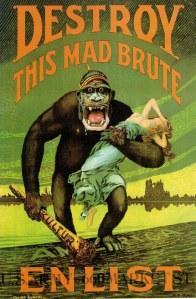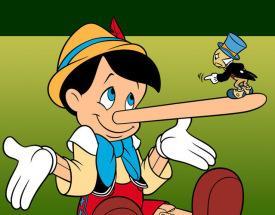The broad masses…more readily fall victims to the big lie than the small lie, since they themselves often tell small lies in little matters but would be ashamed to resort to large-scale falsehoods. It would never come into their heads to fabricate colossal untruths, and they would not believe that others could have the impudence to distort the truth so infamously. - Adolf Hitler
 One of the most pernicious myths about sex work, common among prohibitionists, the general public, allies and even many activists, is that it is a “special case”; those who believe this pretend that sex work is different from all other forms of sex, all other forms work and (in the most extreme cases) all other human interactions. This is, of course, total and complete nonsense; not only is most sex transactional, but most of the arguments in favor of considering sex to be different from other activities are fallacious at best and pure garbage at worst. Drug-prohibition arguments can usually be converted into sex work-prohibition arguments by changing a few words, most arguments for abortion rights can be converted into arguments for sex worker rights without changing any words, and many, many issues bear a strong resemblance to sex work controversies for anyone with eyes to see. Because of this profound lack of valid differences I am never surprised when I encounter an article about something else which also says something about sex work; in this case it was especially unsurprising because neofeminist anti-sex propaganda all proceeds from the same vile agenda. Wendy McElroy’s “The Big Lie of a Rape Culture” is well worth reading in its own right, but since I’ve already written often about this false construct, its history, its construction and its legacy, I figured it would be more productive to compare the “rape culture” lie with the “sex trafficking” one instead. This bullet-point list from McElroy’s article is of particular interest:
One of the most pernicious myths about sex work, common among prohibitionists, the general public, allies and even many activists, is that it is a “special case”; those who believe this pretend that sex work is different from all other forms of sex, all other forms work and (in the most extreme cases) all other human interactions. This is, of course, total and complete nonsense; not only is most sex transactional, but most of the arguments in favor of considering sex to be different from other activities are fallacious at best and pure garbage at worst. Drug-prohibition arguments can usually be converted into sex work-prohibition arguments by changing a few words, most arguments for abortion rights can be converted into arguments for sex worker rights without changing any words, and many, many issues bear a strong resemblance to sex work controversies for anyone with eyes to see. Because of this profound lack of valid differences I am never surprised when I encounter an article about something else which also says something about sex work; in this case it was especially unsurprising because neofeminist anti-sex propaganda all proceeds from the same vile agenda. Wendy McElroy’s “The Big Lie of a Rape Culture” is well worth reading in its own right, but since I’ve already written often about this false construct, its history, its construction and its legacy, I figured it would be more productive to compare the “rape culture” lie with the “sex trafficking” one instead. This bullet-point list from McElroy’s article is of particular interest:
- The lie must be “grossly impudent” and “colossal” — for example, the lie that men and women are not human beings who share the same political interests, such as freedom of speech, but are separate classes with separate and antagonistic political interests.
- The lie must be frequently repeated, because some people believe whatever they hear often enough or from enough people. For example, PC feminists who endorse the idea of a “rape culture” also interpret everything in society through its lens, from casual glances to the prospect of a nuclear winter. It is the constant explanation.
- It should make the average person ask, “Who would lie about that?” It is assumed that women would not lie about rape, and that feminists would not commit the intellectual crime of a mass fabrication about women. After all, aren’t they for women?
- A big lie must be maintained by the state. For example, tax-funded campuses become places where ideas are stifled rather than explored. In classrooms, only “correct” discussions occur, and they do so only by using “correct” words.
- A big lie must impact “the deeper strata” of people’s “emotional nature.” Few images elicit as much emotion as that of women being savagely raped. That’s why “they are coming to rape our women!” has been a popular rallying cry to rouse men into battle.
- It must be something many people wish to believe. The gender war has broadened and deepened since the ‘70s. There is a palpable anger within PC feminism and within many women who feel oppressed, whether or not they really are. The “rape culture” myth appeals to that anger.
- A big lie is best expressed in a tone of moral outrage and in the name of a noble goal. Both aspects discourage casual critics and allow the liars to vilify any critic who dares to proceed. The rape-culture myth is advanced in the name of protecting women,
 and anyone who questions it is said to be defending rapists.
and anyone who questions it is said to be defending rapists.
I think even the most casual reader can see how McElroy’s points also apply to the big lie of “sex trafficking”; note how few of her words I had to change here:
- The lie must be “grossly impudent” and “colossal” — for example, the lie that women are wholly incapable of choosing to have sex for pragmatic reasons, so that literally every woman who engages in sex work was forced to do so by evil “pimps” or “traffickers” whether she admits it or not.
- The lie must be frequently repeated, because some people believe whatever they hear often enough or from enough people. (‘Nuff said there, I think.)
- It should make the average person ask, “Who would lie about that?” It is assumed that people who claim they want to “help” women and children would not promote a mass fabrication about them which results in grievous harm to the very people they claim to want to help.
- A big lie must be maintained by the state. (Again, ‘nuff said.)
- A big lie must impact “the deeper strata” of people’s “emotional nature.” Few images elicit as much emotion as that of women being repeatedly raped. Up to 110 times a day, even!
- It must be something many people wish to believe. As I have often pointed out, the myth that men rather than women are in control of the sexual sphere has great emotional appeal to both insecure men and immature or warped women.
- A big lie is best expressed in a tone of moral outrage and in the name of a noble goal. Both aspects discourage casual critics and allow the liars to vilify any critic who dares to proceed. The “sex trafficking myth” is advanced in the name of protecting women and children, and anyone who questions it is said to be defending rapists and slavers.
All prohibitionism is the same, all moral panics are very similar, and it doesn’t take a genius to see the similarities. Unfortunately, recognizing them requires wanting to discover the truth, and the mass of humanity is much more comfortable with big, familiar lies.
